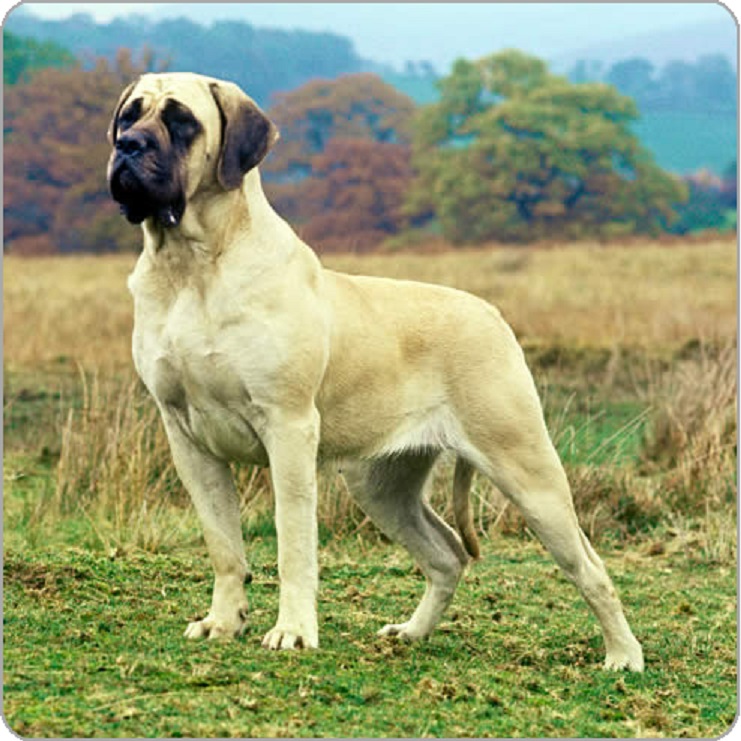
English Mastiff

Navigate through the tabs
Navigate through the tabs below to view the breed's info of your interest.
The breed's info is divided in four sections; namely:
the breed's history ,
the breed's main stats ,
the dog's potential health issues
and finally, how the breed scored in 26 different categories.
All the above information should give you a respectively good overview for the dog of your interest.
Dog Breed's Main Info
The Breed's History:
The Mastiff descends from one of the most ancient types of dogs, the molosser, which probably originated in the mountains of Asia, perhaps in Tibet or northern India.
It would most likely have been used to guard flocks from predators in those cold, high passes.
These molossers were solidly built with heavy bones, a short muzzle, a short, well-muscled neck, and hanging ears. Their ancestry can be seen not only in the Mastiff but also in the Tibetan Mastiff, Saint Bernard, Rottweiler, Dogue de Bordeaux, and many other modern breeds.
Depictions of Mastiff-type dogs appear in the human record throughout the ages, in Egyptian, Babylonian and classical Greek civilizations.
Archaeologists excavating the palace of the Babylonian ruler Ashurbanipal uncovered bas-reliefs dating to the seventh century BCE - more than 2,500 years ago - of a Mastiff-type dog fighting lions.
For millennia, Mastiff-type dogs served as guards, war dogs, and entertainment, being pitted against lions and other fierce animals. The dogs made their way throughout the known world, arriving with armies or transported by traders.
Wherever they went, they were prized for their size and courage. Kublai Khan is said to have had a kennel with 5,000 Mastiffs used for hunting and war. When Hannibal crossed the Alps, he did so with trained war mastiffs.
During their trek, the war dogs crossbred with local dogs, and their offspring became the foundation for the Saint Bernard, the Rottweiler, and other breeds. Even the Pug - described as a Mastiff in miniature - can lay claim to molosser heritage.
In England, where the modern Mastiff was developed, the huge dogs guarded estates, patrolling the grounds at night. Lyme Hall was famous for its strain of Mastiffs, which were bred from the 15th century through the early 20th century, and played a role in saving the breed from extinction.
The breed almost came to an end after 1835, when the brutal sports of bear-baiting, bull-baiting, and dog-fighting were outlawed. But the rise of dog shows in the mid-19th century helped bring about the Mastiff's revival.
They almost died out again during World Wars I and II because food shortages made it impossible to feed them, but a pair of Mastiff puppies imported from Canada after World War II helped bring them back from the brink.
Mastiffs probably came to the United States in colonial times, but it wasn't until 1879 that the first Mastiff club was formed in this country. The American Kennel Club recognized the breed in 1885, and a Mastiff named Bayard was the first of his breed to be registered with the AKC. The current Mastiff Club of America was formed in 1929 and still watches over the breed today, almost 80 years later.
Today, the Mastiff's gentle nature and massive size makes him a much-loved companion throughout the world. He ranks 32nd among the 155 breeds and varieties recognized by the American Kennel Club.
Country of Origin:
England
Breed Group:
Working
Height:
2 feet, 3 inch. to 2 feet, 8 inch. (68,58 to 81,28 cm)
Weight:
130 to 220 pounds (58,97 to 99,8 Kg)
Life Span:
6 to 10 years
Potential Health Issues:
Seizures,
Hip Dysplasia,
Progressive Retinal Atrophy (PRA),
Cancer,
Cystinuria,
Gastric Torsion (Bloat)
Adaptability
Apartment Living:
First Time Owners:
Sensitivity:
Being Alone:
Cold Weather:
Hot Weather:
Friendliness
Affection With Family:
With Kids:
With Dogs:
With Strangers:
Health and Grooming
Shedding:
Drooling:
Easy To Groom:
Overall Health:
Weight Gain Potential:
Size:
Training
Easiness:
Intelligence:
Mouthiness:
Prey Drive:
Barking or Howling:
Wanderlust:
Need For Exercise
Energy Level:
Intensity:
Exercise Needs:
Playfulness:
Our Mobile Application
Check out Our Mobile Application "Dog Breeds Central"
